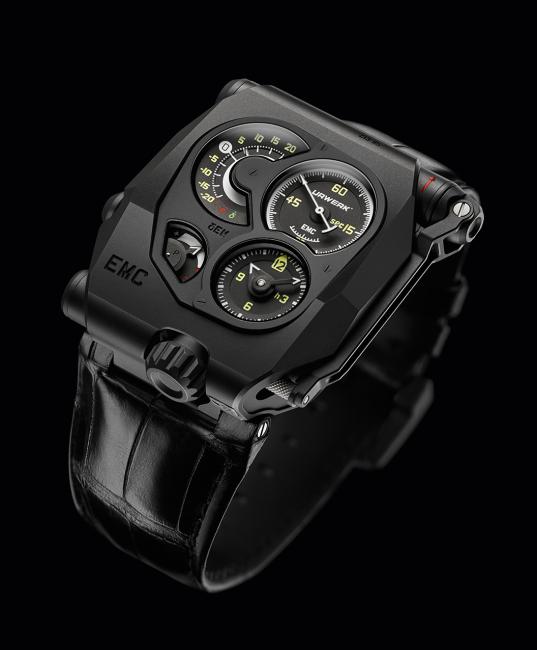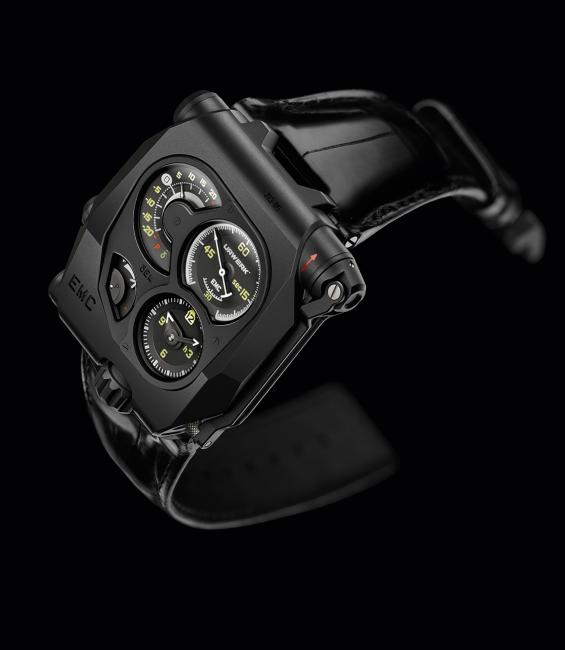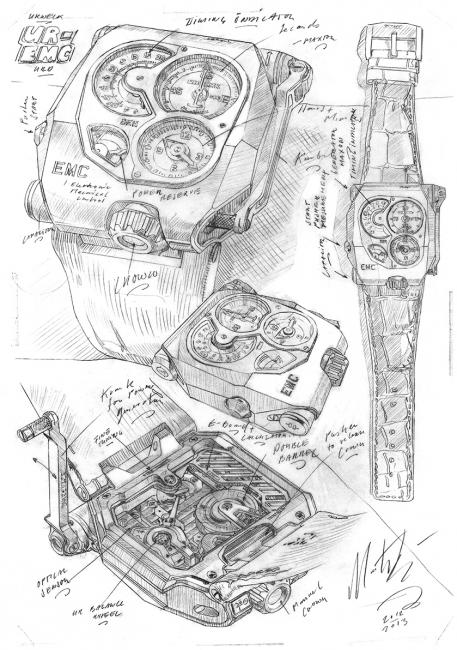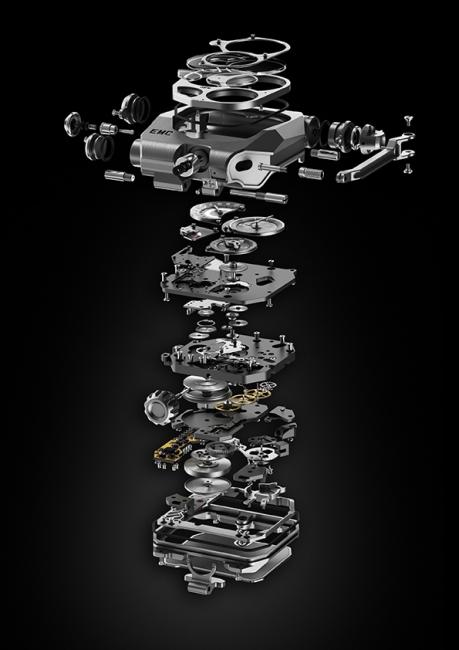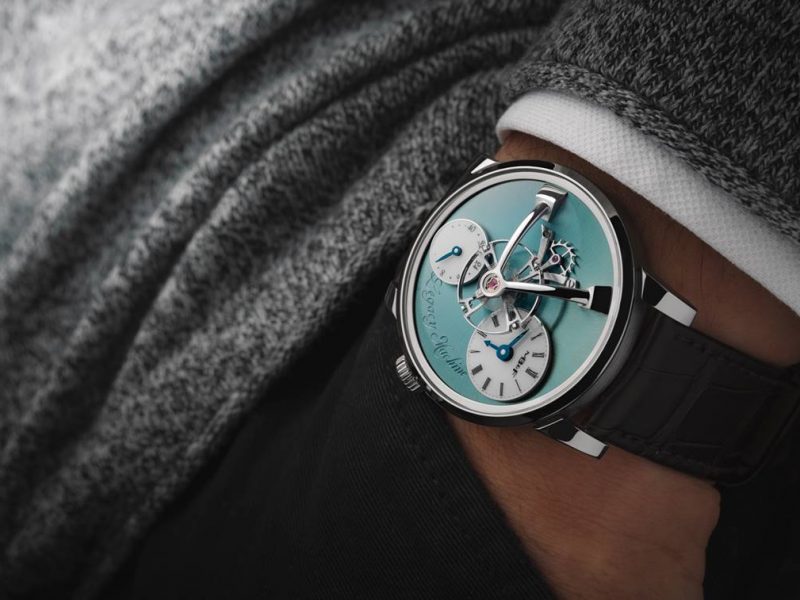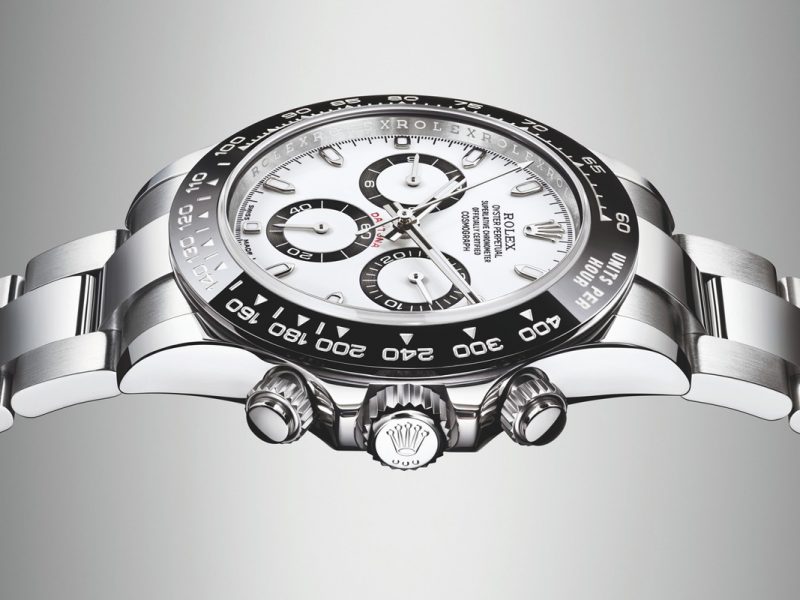URWERK EMC Black with full precision control
Urwerk is known as a brand with a unique approach to watch design and complications. This week, they have launched their latest model, a black DLC coated EMC. When first launched, the EMC – for Electro Mechanical Control – was the world first mechanical watch enabling its owner to monitor the movement’s timing rate and make the necessary adjustments to suit the lifestyle of the wearer.
In addition to EMC’s conventional indications – hours, minutes, seconds and power reserve indicator – is added a completely original performance indicator display, delta/δ, which is activated on demand by a push of a button. This patented, ultra-high precision, performance indicator, is a world first. And the wearer can then easily adjust the movement’s precision (rate) by simply turning a screw on the back. EMC offers the horological Holy Grail: ultimate precision for each individual owner.
While EMC’s movement is 100% mechanical, URWERK have integrated into the movement a timing rate monitoring unit powered by a manual winding generator and super capacitor.
The monitoring unit comprises an optical sensor that captures the timing rate of a specially designed balance wheel; a micro-computer then compares that rate against an ultra-fast (16,000,000 Hz) reference oscillator to calculate the isochronism of the movement i.e. how regular its timing is. Each microsecond difference is expressed as a gain or loss of a second per day of the timing rate, displayed on the precision indicator by pressing a caseband button. Fine-tuning of the rate can then be made using the adjustment screw on the caseback, which changes the active length of the balance spring.
At its heart, EMC offers triple functionality:
- showing how external parameters (positional changes, temperature and pressure) influence the timing of the movement
- enabling the wearer to correct these timing variations by adjusting the rate for the best chronometric performance possible
- facilitating interactivity between the timepiece and its owner – the wearer of the watch also becomes its regulator
Martin Frei, URWERK co-founder and artistic director, explains:
“A mechanical watch can reach stunning levels of chronometric performance in a perfect environment, but only if it exists in its own little bubble, protected from external knocks, at a constant temperature.
However, that is simply not practical. After all, a watch’s raison d’être is being on its owner’s wrist, about how its wearer interacts with it. So we looked at the problem counter-intuitively and gave the wearer – the very person responsible for disrupting its movement’s timing rate – the key to correcting it. It is man’s hand that perfects the mechanics and opens the doors to an infinite power of adaptation.”
EMC features a deconstructed dial with four separate indications: A clockwise tour of the displays, from top left, presents the: on demand, precision indicator (instantaneous rate delta “δ”) ranging from -20 to + 20 seconds per day; seconds dial with counter-balanced seconds hand; hours and minutes; and 80-hour power reserve indicator. Turning EMC over reveals the fully in-house movement with the integrated circuit board – the EMC ‘brain’ – the top of one of the two mainspring barrels near the crown and the top of the balance wheel and optical sensor on the winding handle side.
The EMC timing rate monitoring unit is using an optical sensor on the balance wheel capturing the precise rate of oscillation of the 4 hertz / 28,800 vph regulator, over a period of 3 seconds. This sensor consists of a transmitter and a receiver positioned either side of the balance, and is triggered manually by pressing a button on the left side of the case. The observed timing rate is compared to a 16,000,000-hertz electronic oscillator to obtain the most accurate measurement possible. An integrated circuit determines the difference between the timing rate of the movement and that of the reference oscillator. Each microsecond difference between the two values is expressed as a gain or loss of a second per day of the timing rate. A variation of just 0.0000014 of a second per half-vibration translates as a variation of a second per day.
An interesting feature of the EMC is the manual-winding generator, made by the Swiss company Maxon (known for developing motors for NASA’s Mars rovers), that will power the EMC’s monitoring unit.
Now that the all the hysteria around the Apple Watch starts to calm down, here is a timepiece to be really excited about!
Technical specifications
Case
Material: Black DLC treated titanium and steel
Dimensions: 43mm width, 51mm length, 15.8mm height
Crystal: Sapphire crystal
Water resistance: Pressure tested to 30m / 3ATM
Finishing: Shot-blasting
Movement
Calibre: UR-EMC calibre conceived, developed and manufactured by URWERK
Escapement: Swiss lever escapement
Balance wheel: ARCAP P40, linear balance coupled to the optical sensor
Frequency: 28,800 vph – 4Hz
Balance spring: Flat
Energy source: Vertically mounted double mainspring barrels, connected in series
Power reserve: 80 hours
Winding: Manual winding
Finishing: Côtes de Genève, snailing, micro-bead blasting, polished bevels on screw heads
Artificial intelligence
Generator: Maxon® generator with manual winding charging super capacitor
EMC system: Optical sensor controlled by an integrated circuit board ;
16’000’000 Hz reference oscillator
Indications/functions
Hours, minutes, seconds; precision delta, power reserve.
Timing adjustment screw
More about Urwerk at www.urwerk.com


